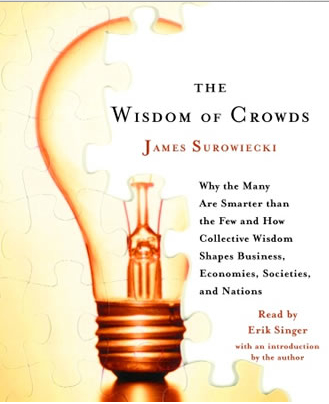
Last February, at a TED (Technology, Education, Design) conference in California, a PhD student named Lior Zoref brought an ox onstage to perform a social experiment. He had each person in the crowd write down what (s)he thought the animal weighed and turn it in. While his assistants were tabulating the answers, he then went on to talk about the wisdom of crowds. James Surowiecki posed the same argument in his 2004 bookThe Wisdom of Crowds: Why the Many Are Smarter Than the Few and How Collective Wisdom Shapes Business, Economies, Societies and Nations. Its central theme is that, quite simply, the collectivebrain-powerof the many is often more accurate than the analysis of the "expert". This is not a new concept. In 1906 the British researcher Francis Galton -who was later knighted - observed the same "phenomenon" at a country fair. The researcherHarriOinas-Kukkonen goes on to submit that
- In some cases, groups are remarkably intelligent and are often smarter than the smartest people in them.
- The three conditions for a group to be intelligent are diversity, independence, and decentralization.
- The best decisions are a product of disagreement and contest. - Productive brain-storming
- Too much communication can make the group as a whole less intelligent. - Sound familiar?
- The right information needs to be delivered to the right people in the right place, at the right time, and in the right way.
- There is no need to chase the expert. - Aha - the avalanche 'expert'
But there's the fine print. It implies that each individual must come up with his or her own answer or opinion independent of what others offer or opine. For example, through social experiments, the researchers Lorenz, Rauhut, Schweitzer, andHelbing^1 found that as testing progressed, the average answers of independent test subjects became more accurate, in keeping with the wisdom-of-crowds phenomenon. Socially influenced test subjects, however, actually became less accurate. In other words, Group Think is not only less accurate, but perhaps dangerous.
And this is where Observations from the backcountry come in. We, the "experts" go in the mountains and come away with our subjective opinion on the state of the snowpack. But it's just one man's (or in Evelyn's case - woman's) opinion. How could we actually be as accurate as the crowd in the backcountry? This is why - at the end of each class, lecture, or presentation, with some tongue-in-cheek - I offer that at the Utah Avalanche Center, our forecasts are always right. But you...you can help us be more right. Submit your obs to the UAC. Stick to your convictions - don't be swayed by everyone else's opinions - you might be right after all.
And the ox? All the independently arrived-at answers averaged out to be 1792 pounds. The actual weight of the farm animal? You guessed it - 1795 lbs.
We look forward to your reports from the backcountry -
Drew Hardesty
"Avalanche Expert", Utah Avalanche Center







